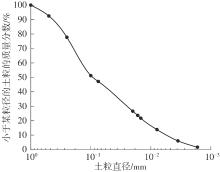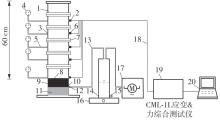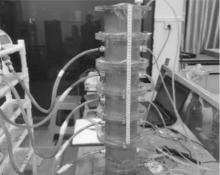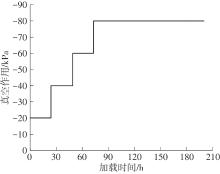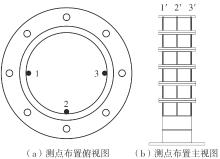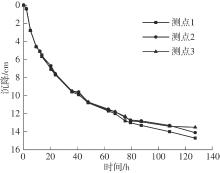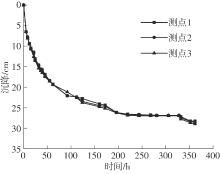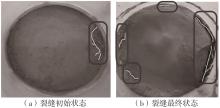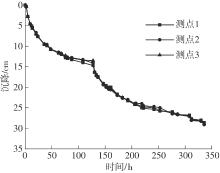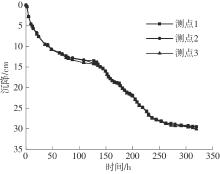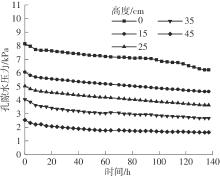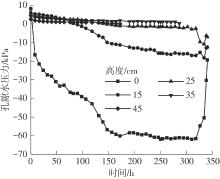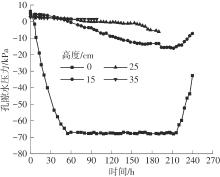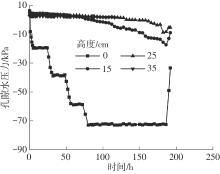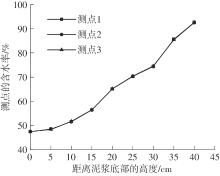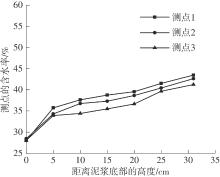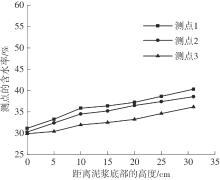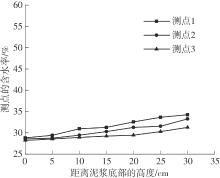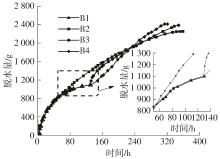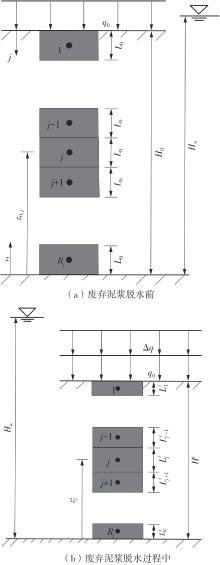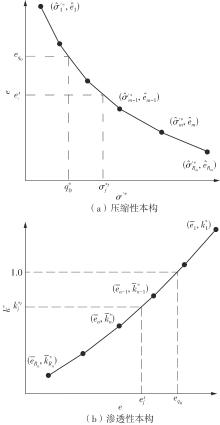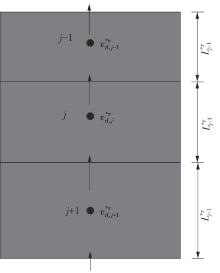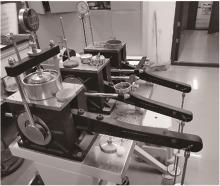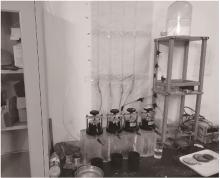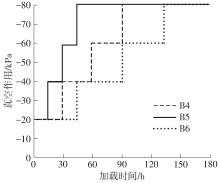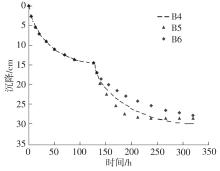华南理工大学学报(自然科学版) ›› 2024, Vol. 52 ›› Issue (11): 69-82.doi: 10.12141/j.issn.1000-565X.230736
盾构废弃粉质黏土泥浆底部真空脱水试验研究
- 郑州大学 土木工程学院,河南 郑州 450001
Experimental Study on Vacuum Dehydration of Waste Silty Clay Slurry in Shield Tunneling
GAO Xinjun( ), WANG Jianbo, SU Qinghui, LIU Zhongyu, WANG Lei, ZHOU Tonghe
), WANG Jianbo, SU Qinghui, LIU Zhongyu, WANG Lei, ZHOU Tonghe
- School of Civil Engineering,Zhengzhou University,Zhengzhou 450001,Henan,China
-
Received:2023-11-26Online:2024-11-25Published:2024-06-07 -
About author:郜新军(1981—),男,博士,副教授,主要从事岩土工程及城市地下工程研究。E-mail:gxjun@zzu.edu.cn -
Supported by:the National Natural Science Foundation of China(51578511)
摘要:
盾构施工中产生的废弃粉质黏土泥浆具有含水率高、强度低、颗粒粒径较小及难以快速固结的特点,脱水处置难度大;如何对其进行有效的脱水固化处理,是减少其在运输或存储过程中污染环境的关键。基于自行研制的废弃泥浆真空脱水装置,开展自重、自重+真空、自重稳定+真空、自重稳定+分级真空等4种不同形式下的室内脱水模型试验研究,分析废弃粉质黏土泥浆在不同的加载方式下泥—水界面沉降、孔隙水压力、脱水量以及脱水后残余泥浆含水率的变化规律,并对不同加载方式下对废弃粉质黏土泥浆的脱水效果进行对比。试验结果表明:4种脱水方式中,先对废弃粉质黏土泥浆进行自重脱水处理、再对其底部分级施加真空作用的加载方式对废弃粉质黏土泥浆的脱水效果最好,可有效降低废弃粉质黏土泥浆的含水率;采用该方法对初始含水率为97.50%的废弃粉质黏土泥浆进行脱水处理后,其含水率分布范围介于28.21%~34.25%,其内部孔隙水压力最小可达-72.92 kPa。同时,基于分段线性化的思想建立了废弃泥浆一维脱水理论分析模型,对废弃粉质黏土泥浆在脱水过程中的泥—水界面沉降进行数值模拟,并将数值模拟与试验结果进行了对比分析;随后通过对不同加载方式下脱水效率进行模拟分析探究了最佳加载方式。该研究可为盾构废弃粉质黏土泥浆快速脱水处理提供理论基础和实践依据。
中图分类号:
引用本文
郜新军, 王剑博, 苏庆辉, 等. 盾构废弃粉质黏土泥浆底部真空脱水试验研究[J]. 华南理工大学学报(自然科学版), 2024, 52(11): 69-82.
GAO Xinjun, WANG Jianbo, SU Qinghui, et al. Experimental Study on Vacuum Dehydration of Waste Silty Clay Slurry in Shield Tunneling[J]. Journal of South China University of Technology(Natural Science Edition), 2024, 52(11): 69-82.
| 1 | QI Y, THAPA K B, HOADLEY A F A .Application of filtration aids for improving sludge dewatering properities-a review[J].Chemical Engineering Journal,2011,171(2):373-384. |
| 2 | 孙晓辉,郭柯雨,姬凤玲,等 .盾构泥浆絮凝-固化联合作用试验研究及宏细观探析[J].隧道建设(中英文),2022,42(4):602-610. |
| SUN Xiaohui, GUO Keyu, JI Fengling,et al .Macro-and meso-coupling effect of flocculation-solidification of waste shield slurry[J].Tunnel Construction,2022,42(4):602-610. | |
| 3 | 李悦,李俊才,汪效祖,等 .废弃钻孔泥浆快速泥水分离试验研究[J].科学技术与工程,2020,20(25):10366-10371. |
| LI Yue, LI Juncai, WANG Xiaozu,et al .Experimental study of rapid water separation from slurry of drilling mud[J].Science Technology and Engineering,2020,20(25):10366-10371. | |
| 4 | 王东星,伍林峰,唐弈锴,等 .建筑废弃泥浆泥水分离过程与效果评价[J].浙江大学学报(工学版),2020,54(6):1049-1057. |
| WANG Dong-xing, WU Lin-feng, TANG Yi-kai,et al .Mud-water separation process and performance evaluation of waste slurry from construction engineering[J].Journal of Zhejiang University (Engineering Science),2020,54(6):1049-1057. | |
| 5 | HE J, CHU J .Sedimentation behavior of flocculant-treated soil slurry[J].Marine Georesources and Geotech-nology,2017,35(5):593-602. |
| 6 | 李旭 .泥水盾构废弃泥浆絮凝脱水试验研究[J].铁道建筑,2018,58(5):144-147. |
| LI Xu .Flocculation and dehydration experimental study of waste mud in slurry shield[J].Railway Engineering,2018,58(5):144-147. | |
| 7 | 孙肖 .改性壳聚糖絮凝剂改善污泥脱水性能的研究[D].哈尔滨:哈尔滨工业大学,2009. |
| 8 | 冯源,詹良通,陈云敏 .城市污泥电渗脱水实验研究[J].环境科学学报,2012,32(5):1081-1087. |
| FENG Yuan, ZHAN Liangtong, CHEN Yunmin .Laboratory study on electroosmosis dewatering of sewage sludge[J].Acta Scientiae Circumstantiae,2012,32(5):1081-1087. | |
| 9 | CHIEN S C, OU C Y .A novel technique of harmonic waves applied electro-osmotic chemical treatment for soil improvement[J].Applied Clay Science,2011,52(3):235-244. |
| 10 | 梁嘉林 .氧化-絮凝调理对市政污泥超高压压滤深度脱水的影响及其机理研究[D].广州:广东工业大学,2020. |
| 11 | FENG S, LEI H, WANG L,et al .The reinforcement analysis of soft ground treated by thermal consolidation vacuum preloading[J].Transportation Geotechnics,2021,31:100672/1-8. |
| 12 | 蒋楚生,司文明,曾惜,等 .电渗联合真空预压技术处理高速铁路软土地基[J].铁道工程学报,2019,36(6):28-32,96. |
| JIANG Chusheng, SI Wenming, ZENG Xi,et al .Research on the treatment of soft soil foundation of a high speed railway by electric-osmosis combined with vacuum preloading technology[J].Journal of Railway Engineering Society,2019,36(6):28-32,96. | |
| 13 | 曹杰,郑建国,刘智,等 .真空预压法处理软土地基的工程应用[J].岩土工程学报,2017,39(S2):124-127. |
| CAO Jie, ZHENG Jianguo, LIU Zhi,et al .Application of vacuum preloading method in consolidating soft soil foundation[J].Chinese Journal of Geotechnical Engineering,2017,39(S2):124-127. | |
| 14 | BERGADO D T, JAMSAWANG P, JONGPRADIST P,et al .Case study and numerical simulation of PVD improved soft Bangkok clay with surcharge and vacuum preloading using a modified air-water separation system[J].Geotextiles and Geomembranes,2022,50(1):137-153. |
| 15 | LIN S, FU D F, ZHOU Z F,et al .Numerical investigation to the effect of suction-induced seepage on the settlement in the underwater vacuum preloading with prefabricated vertical drains[J].Journal of Marine Science and Engineering,2021,9(8):797/1-26. |
| 16 | TER-MARTIROSYAN Z G, TER-MARTIROSYAN A Z, STRUNIN P V,et al .Stress-strain state of thick-walled soil cylinder with sand core and grillage view of elastoplastic properties of the soil[J].Procedia Engineering,2014,91:286-291. |
| 17 | 武亚军,顾赛帅,强小兵,等 .基于骨架构建药剂真空预压法加固超软土试验[J].浙江大学学报(工学版),2018,52(4):735-743. |
| WU Ya-jun, GU Sai-shuai, QIANG Xiao-bing,et al .Experimental study on ultra-soft soil reinforced by vacuum preloading with flocculation based on skeleton construction[J].Journal of Zhejiang University (Engineering Science),2018,52(4):735-743. | |
| 18 | 魏雁冰,范明桥,林生法,等 .建筑废弃泥浆真空预压方法处理试验研究[J].郑州大学学报(工学版),2016,37(1):65-69. |
| WEI Yanbing, FAN Mingqiao, LIN Shengfa,et al .Experimental study on construction waste slurry treatment by vacuum preloading[J].Journal of Zhengzhou University (Engineering Science),2016,37(1):65-69. | |
| 19 | 胡圣祥 .真空压力加载方式对泥浆固结效果的影响[J].水电能源科学,2014,32(1):125-127. |
| HU Shengxiang .Impacts of vacuum loading methods on consolidation of slurry[J].Water Resources and Power,2014,32(1):125-127. | |
| 20 | 吴思麟,朱伟,闵凡路,等 .泥浆真空抽滤泥水分离中堵塞机理及规律性研究[J].岩土工程学报,2017,39(8):1530-1537. |
| WU Si-lin, ZHU Wei, MIN Fan-lu,et al .Clogging mechanism and effect of cake permeability in soil-water separation using vacuum filtration[J].Chinese Journal of Geotechnical Engineering,2017,39(8):1530-1537. | |
| 21 | 土工试验方法标准: [S]. |
| 22 | 詹良通,张斌,郭晓刚,等 .废弃泥浆底部真空—上部堆载预压模型试验研究[J].岩土力学,2020,41(10):3245-3254. |
| ZHAN Liangtong, ZHANG Bin, GUO Xiaogang,et al .Physical modeling study on treatment of waste slurry with vacuum preloading at bottom combined with upper surcharge loading[J].Rock and Soil Mechanics,2020,41(10):3245-3254. | |
| 23 | 王海波,王树英,胡钦鑫,等 .盾构砂性渣土—泡沫混合物渗透性影响因素研究[J].隧道建设(中英文),2018,38(5):833-838. |
| WANG Haibo, WANG Shuying, HU Qinxin,et al .Study on influencing factors of permeability of sand-foam mixture for shield tunneling[J].Tunnel Construction,2018,38(5):833-838. | |
| 24 | 魏康林 .土压平衡式盾构施工用泡沫混和土透水性试验研究[J].现代隧道技术,2005,42(5):17-21. |
| WEI Kanglin .Research on the permeability of the foamed soil adopted in EPB shield tunneling[J].Modern Tunnel Technology,2005,42(5):17-21. | |
| 25 | FOX P J, BERLES J D .CS2:a piecewise-linear model for large strain consolidation[J].International Journal for Numerical and Analytical Methods in Geomechanics,1997,21(7):453-475. |
| 26 | 江辉煌,刘国楠,赵有明 .Gibson一维固结方程的一种求解方法[J].岩土工程学报,2010,32(5):745-750. |
| JIANG Hui-huang, LIU Guo-nan, ZHAO You-ming .A solution of Gibson’s governing equation of one-dimensional consolidation[J].Chinese Journal of Geotechnical Engineering,2010,32(5):745-750. |
| [1] | 魏海斌, 魏东升, 蒋博宇, 等. 基于IPSO-SVR的盾构下穿既有道路沉降预测分析[J]. 华南理工大学学报(自然科学版), 2023, 51(6): 62-71. |
| [2] | 谢杰辉, 牛富俊, 彭智育, 等. 滨海高速公路软基变形规律及沉降预测应用[J]. 华南理工大学学报(自然科学版), 2021, 49(4): 97-107. |
| [3] | 李汴生 谭莉 周厚源 阮征 郭伟波 林光明 杨焕彬. 肉鸡烤翅热杀菌过程的热穿透特性及品质动力学[J]. 华南理工大学学报(自然科学版), 2015, 43(2): 13-19. |
| [4] | 唐智 方正 袁建平 王骏横. 水颗粒作用下火灾烟气层沉降的数值模拟[J]. 华南理工大学学报(自然科学版), 2015, 43(12): 71-76,84. |
| [5] | 李恒真 姚思海 杨昆升 杨颖 刘刚 李立浧. 污秽颗粒在绝缘表面吸附前的受力和运动分析[J]. 华南理工大学学报(自然科学版), 2013, 41(4): 21-26. |
| [6] | 汪益敏 李庆臻 高水琴. 差异沉降对土工格栅加筋路堤工作性能影响的试验研究[J]. 华南理工大学学报(自然科学版), 2011, 39(9): 68-74. |
| [7] | 潘健 胡巍巍. 地面水平位移对斜桩基础的负面效应[J]. 华南理工大学学报(自然科学版), 2008, 36(6): 6-9. |
| [8] | 陈平山 莫海鸿. 真空预压加固地基等效固结度的简化计算[J]. 华南理工大学学报(自然科学版), 2008, 36(1): 139-144. |
| [9] | 潘健 王兴斌 刘利艳 顾太华. 基于节约理念的带桩筏基设计方法[J]. 华南理工大学学报(自然科学版), 2007, 35(7): 137-142. |
| [10] | 周少基 郭祀远 李琳. 波纹斜槽板沉降器中的旋流絮凝特性[J]. 华南理工大学学报(自然科学版), 2007, 35(4): 67-71. |
| [11] | 郭祀远 周少基 李琳. 糖用微涡流重力沉降器中的流体特征流动与颗粒絮凝沉降[J]. 华南理工大学学报(自然科学版), 2007, 35(10): 131-136. |
| [12] | 寇灵梅 李冰 郭祀远 李琳 杨洁贞. 磁性壳聚糖微球的表征及其磁响应性[J]. 华南理工大学学报(自然科学版), 2006, 34(12): 92-95,100. |
| [13] | 张功新 董志良 莫海鸿 赵建国. 真空预压中真空度及其测试和分析[J]. 华南理工大学学报(自然科学版), 2005, 33(10): 57-61. |
| 阅读次数 | ||||||
|
全文 |
|
|||||
|
摘要 |
|
|||||
